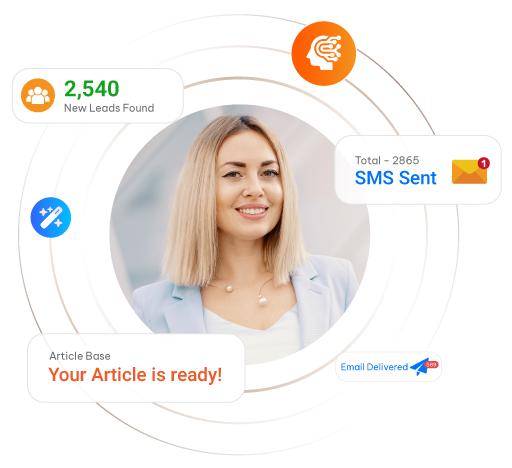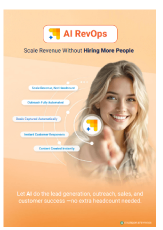Responding to leads within five minutes can boost qualification chances by 400 times for SaaS companies. Automated sales development tools, like AI-powered agents, engage visitors instantly, reducing lead response time and improving conversion rates. This approach enhances efficiency, personalization, and revenue growth in competitive SaaS markets.
TL;DR
- Responding to leads within five minutes can boost qualification chances by 400 times, making speed crucial for SaaS companies.
- Automated tools, like AI-powered agents, engage visitors instantly, reducing lead response time from hours to seconds and improving sales funnels.
- SaaS sales automation not only speeds up processes but also qualifies leads efficiently, increasing conversion rates by 20% compared to manual methods.
- AI-driven tools offer 24/7 operation, ensuring no lead is missed, and provide data insights to refine strategies over time.
- Reducing lead response time is essential in competitive markets to prevent losing prospects to faster competitors.
- AI helps by processing natural language, scoring leads, and integrating with CRMs, leading to up to 30% faster sales cycles.
- Implementing automation effectively involves mapping visitor journeys, setting up triggers, and training AI for accurate responses.
- Automation solves resource constraints by handling routine tasks, maintaining consistency, and enhancing personalization.
- Faster lead response times directly impact revenue, with examples showing a 35% revenue increase from reduced response times.
- Future trends in SaaS sales automation include more complex AI interactions and predictive features, with automation expected to dominate 70% of sales touches by 2027.
Embrace SaaS sales automation to revolutionize your lead conversion process, enhance efficiency, and gain a competitive edge. Contact us to explore how you can implement these solutions and capture more opportunities today.
Table of Contents
Did you know that responding to leads within five minutes boosts your qualification chances by 400 times? For SaaS companies, every second counts in turning visitors into customers. This reality drives the need to reduce lead response time with tools like CloudApper AI Sales Agent.
For more information on CloudApper AI RevOps visit our page here.
How Can You Reduce Lead Response Time in SaaS?
SaaS businesses thrive on speed, yet many struggle with slow responses that let hot leads slip away. Therefore, implementing automated tools changes the game. For example, AI-powered agents jump in the moment a visitor lands on your site. They start conversations instantly, asking questions to gauge interest and needs. This approach slashes wait times from hours to seconds. Moreover, it keeps potential customers engaged before they bounce to competitors. Teams that adopt this method see immediate improvements in their sales funnels. However, success depends on choosing the right tool that integrates seamlessly with your existing systems.
What Are the Benefits of SaaS Sales Automation for Lead Conversion?
Automation in SaaS sales does more than just speed things up. It qualifies leads efficiently, ensuring your team focuses on high-potential prospects. For instance, an AI agent analyzes visitor behavior and tailors responses accordingly. This personalization makes interactions feel genuine and relevant. Therefore, conversion rates climb as visitors receive the attention they crave. Studies show that companies using automation convert 20% more leads than those relying on manual processes. Additionally, it operates 24/7, covering off-hours and weekends without extra staff. However, the real win comes from data insights that help refine your strategies over time.
Why Is Reducing Lead Response Time Crucial for SaaS Growth?
In competitive SaaS markets, delays kill deals. Prospects expect quick answers, and if you hesitate, they move on. Therefore, tools that reduce lead response time SaaS sales automation become essential. They engage users through chat interfaces, guiding them toward demos or sign-ups. For example, if a visitor lingers on your features page, the agent offers a quick overview and books a call. This proactive stance prevents lead decay and builds trust fast. Moreover, it aligns with buyer expectations in 2025, where instant gratification rules. However, ignoring this trend risks falling behind rivals who automate effectively.
How Does AI Help in SaaS Sales Automation?
AI takes center stage in modern sales strategies. It processes natural language to understand queries and provide spot-on replies. Therefore, your team saves time on initial outreach. For instance, an AI sales agent scores leads based on criteria like budget and company size. This filtering passes only qualified ones to human reps. Additionally, it integrates with CRMs to log interactions automatically. However, the technology evolves quickly, incorporating predictive analytics to foresee needs. Teams report up to 30% faster sales cycles thanks to these capabilities.
What Tools Can Reduce Lead Response Time in SaaS?
Several tools excel at this, but AI-driven ones lead the pack. They detect intent and respond in real time. For example, platforms like CloudApper AI Sales Agent handle multiple conversations at once. This scalability suits growing SaaS firms. Therefore, you avoid bottlenecks during traffic spikes. Moreover, they offer customization to match your brand voice. However, evaluating options based on integration ease and cost ensures the best fit. Many users praise how these tools boost efficiency without overwhelming budgets.
How to Implement SaaS Sales Automation Effectively?
Start by mapping your visitor journey. Identify pain points where delays occur. Then, deploy an automation tool that addresses them. For instance, set up triggers for specific pages or actions. This setup ensures timely engagements. Additionally, train the AI on your product details for accurate responses. Therefore, visitors get value right away. However, monitor performance through analytics to tweak as needed. Teams that follow this path often see a 25% increase in lead quality. Read more about implementing SaaS sales automation effectively.
What Challenges Does SaaS Sales Automation Solve?
Resource constraints plague many SaaS teams. Automation tackles this by handling routine tasks. For example, it qualifies leads around the clock, freeing reps for closings. Moreover, it maintains consistency in messaging, reducing errors. However, some worry about losing the human touch. Advanced AI mitigates this with empathetic, conversational tones. Therefore, you enhance experiences without sacrificing personalization. In crowded markets, this edge drives revenue growth.
Why Choose Automated Sales Development for SaaS?
Automated sales development streamlines the entire process. It turns passive visitors into active leads through instant interactions. For instance, agents suggest resources or demos based on behavior. This guidance accelerates decisions. Additionally, it provides metrics on engagement, helping optimize campaigns. However, the key lies in seamless integration with tools like email and calendars. Teams leveraging this report higher satisfaction and faster ROI.
What Future Trends Shape SaaS Sales Automation?
Looking ahead, AI will handle even more complex interactions. Predictive features will anticipate questions before they arise. Therefore, engagement becomes proactive. For instance, integrating with voice tech could expand reach. Additionally, data privacy advancements will build user trust. However, staying updated on trends like these keeps you competitive. Experts predict that by 2027, automation will dominate 70% of sales touches. Learn more about future trends shaping SaaS sales automation.
How Can You Measure Success in Reducing Lead Response Time?
Track metrics such as average response time and conversion rates. Use dashboards for real-time insights. For example, compare pre- and post-automation data. This reveals improvements clearly. Moreover, gather feedback from leads on their experience. Therefore, you refine approaches continuously. However, focus on qualitative gains like team productivity too. Successful implementations often yield double-digit growth in key areas.
Embracing tools like CloudApper AI Sales Agent to reduce lead response time SaaS sales automation revolutionizes how you convert visitors. It delivers speed, efficiency, and insights that propel your business forward. Start exploring options today to capture more opportunities and outpace the competition.

Scale Revenue. No Extra Hires
AI Agents that find prospects, nurture leads, engage visitors,
close deals & support customers - automatically
How to Implement SaaS Sales Automation Effectively
- Map Your Visitor Journey: Begin by identifying key touchpoints in your visitor's journey where delays occur. This foundational step ensures your automation effectively targets potential lag points.
- Deploy Automation Tools: Choose an AI sales agent that matches your needs. Set up triggers for visitor actions and specific web pages to initiate timely engagements. Ensure this tool integrates seamlessly with your CRM and calendar systems.
- Train Your AI: To provide accurate responses, train the AI agent on your product details and typical customer queries. This training ensures visitors receive precise information quickly.
- Monitor and Optimize: Use analytics to track engagement and conversion metrics. Adjust strategies based on data insights to continually refine your automation process. Explore more about effective implementation by reading how to optimize SaaS sales automation.
- Ensure Continuous Improvement: Regularly update your AI's training and reevaluate your automation strategies to accommodate changes in visitor behavior and expectations.

Scale Revenue Without Hiring More People
Meet the AI Team Behind Your Revenue Growth
CloudApper’s AI Revenue Operations Team helps you scale without the cost and complexity of hiring.
Learn more | Download BrochureFAQs on Reducing Lead Response Time in SaaS
- Why is reducing lead response time important for SaaS companies?
Reducing lead response time is crucial because it significantly increases the chances of qualifying leads, as prospects expect swift interactions. According to studies, responding within five minutes improves qualification rates by 400 times. - How can automation help in reducing lead response time?
Automation tools, especially AI-powered agents, facilitate instant engagement with visitors, reducing the waiting period and increasing the likelihood of conversion. - What are the benefits of using AI in sales automation?
AI automates lead qualification, response personalization, and scheduling, enhancing efficiency. It offers 24/7 service, ensuring no lead is lost due to off-hours, and assists in providing analytics for strategic improvements. - How does using an AI agent impact conversion rates?
AI agents improve conversion rates by offering personalized and timely responses to visitor queries, thus enhancing engagement. Learn more about how conversion rates climb with AI solutions. - What future trends are expected in SaaS sales automation?
Upcoming trends include more sophisticated AI interactions and predictive analytics that anticipate needs, making the process proactive. Read about future trends shaping SaaS sales automation.
What is CloudApper AI Platform?
CloudApper AI is an advanced platform that enables organizations to integrate AI into their existing enterprise systems effortlessly, without the need for technical expertise, costly development, or upgrading the underlying infrastructure. By transforming legacy systems into AI-capable solutions, CloudApper allows companies to harness the power of Generative AI quickly and efficiently. This approach has been successfully implemented with leading systems like UKG, Workday, Oracle, Paradox, Amazon AWS Bedrock and can be applied across various industries, helping businesses enhance productivity, automate processes, and gain deeper insights without the usual complexities. With CloudApper AI, you can start experiencing the transformative benefits of AI today. Learn More
AI RevOps Agent
Scale Revenue Without Hiring More People
Download Brochure


Amplifier Agent
Keeps Your Brand Visible With Articles & Social Media Content That Connects.
Learn More
Outreach Agent
Launches Email & SMS Campaigns That Reach Out on Time and Actually Convert.
Learn More


- Works with
Similar Posts

Automate Email Scheduling and Lead Nurturing to Shorten B2B SaaS…

Strengthen SaaS Deal Flow via Automated Email and SMS Tactics

















